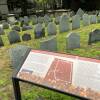Advisory: This story includes descriptions of abuse and oppression of Black people, which were the norm in colonial-era Boston.
The burial ground just steps from Boston Common is the last resting place of some of the titans of Old Boston — and some of the enslaved people who helped them achieve that status.
The Granary Burying Ground, established in 1660, is host to some of the biggest names of the American Revolution: Samuel Adams, James Otis and Paul Revere. But the biggest name here, as with his signature on the Declaration of Independence, may be John Hancock.
At the cemetery, an obelisk stands to mark the Hancock burial ground, and tourists flock by to pay respects to the revolutionary hero. A small, nondescript stone nearby gets less attention. It marks the grave of “Frank, servant to Hancock.” Frank was likely an enslaved person, city officials say, though his name is not among the eight enslaved people Hancock is known to have inherited.
Hancock is frequently referred to as the “checkbook” of the Revolution; it was his vast wealth that paid for much for the political organizing and agitating in the run up to the Boston Tea Party.
His money was inextricably tied to the slave trade. Hancock inherited his fortune and an international shipping empire from his uncle Thomas Hancock. Thomas Hancock partnered in his business with Charles Apthorp, known as one of the most prolific slave traders in Colonial Boston. While there is no record of Hancock boats carrying enslaved people, they almost certainly carried products produced by enslaved people or delivered to plantations that employed enslaved workers.
One of Hancock’s most famous boats, the Liberty, shows the deep web of slavery. On May 9, 1768, the boat landed in Boston, loaded with Madeira wine. Hancock’s crew unloaded most of the wine before customs agents could inspect it. The British then impounded the ship, stirring a small mob at the docks and raising Hancock’s profile as a victim of royal oppression.
And the Maderia wine that sparked the incident would not have been on the boat if not for enslaved labor, says historian David Hancock who wrote a history of the wine. A distant relative of John Hancock, David Hancock said the large barrels in which Maderia was shipped (called “pipes”) were generally reused sugar casks that had been assembled by enslaved workers in the Caribbean. And while there were not a lot of enslaved people working in the Maderia vineyards, the island had a significant enslaved population involved in most of the economic activity, including shipping.
This story is part of the project Enslavement History of the Freedom Trail, a collaborative effort between GBH News and Boston University students to detail the mostly hidden history behind some of Boston's most well-known sites.








